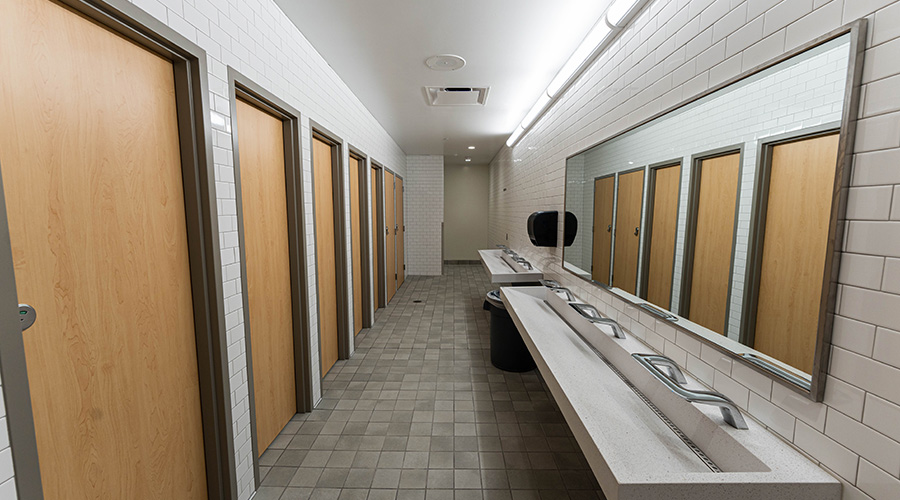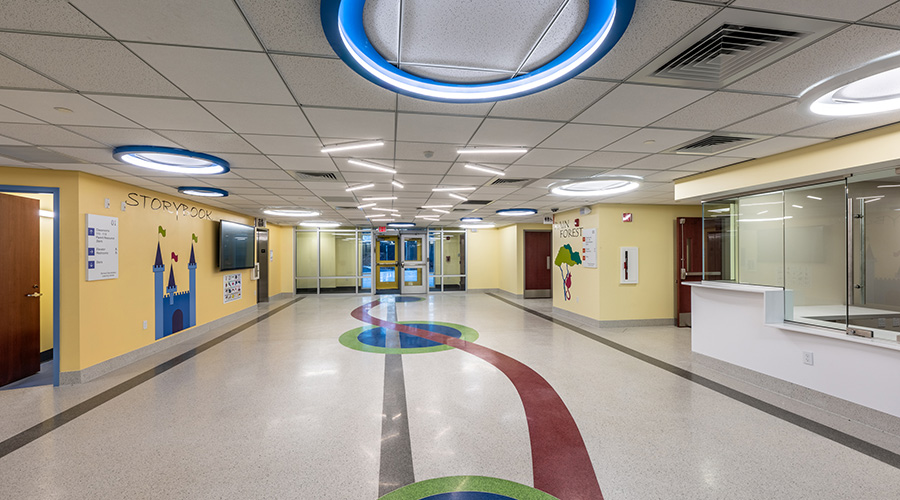in conjunction with NAIMA North American Insulation Manufacturers Association
Cutting the Clamor in Classrooms
Insulation can help control noise in education facilities and enhance student performance
A simple demonstration at the AHR Exposition in February featured four air-handling ducts made of sheet metal. Different types of fiberglass insulation lined the inside of three of the ducts, while the fourth one had no internal insulation. By positioning a sound-emitting speaker at one end of the ducts, visitors could listen at the other end evaluate the insulations’ ability to reduce transmitted noise through the duct.
To the naked ear, the unlined sheet-metal duct transmitted most of the sound, while the insulation-lined ducts transmitted almost no sound. Of course, the naked ear counts when it comes to room acoustics.
The exhibit demonstrated the degree to which fiberglass insulation duct liner absorbs internal noise from an HVAC system. Such noise often originates from equipment, such as fans. But it also can come from high-velocity air moving through the duct. In any case, fiberglass insulation duct liner is an extremely effective tool for suppressing noise in institutional and commercial facilities.
Noise pollution is becoming a particular concern among many occupants of buildings. Maintenance and engineering managers in these facilities — perhaps most importantly, K-12 schools, colleges and universities — might consider using insulation to help solve acoustical problems.
Lessons in Noise Pollution
HVAC systems often contribute to noise pollution in schools. Many of these noise-related problems arise from decisions made during a building’s design and construction.
While fiberglass duct liner is very effective in absorbing sound, it generally costs more. Be-cause of budget constraints, some educational organizations eliminate or fail to consider duct insulation during design. As a result, many classrooms are noisier — some are much nosier — than they should be or need to be.
Besides noise problems associated with unlined sheet-metal ducts, other factors contribute to noise pollution. For example, some pieces of equipment generate greater levels of noise than others.
Schools built under tight budgets often feature smaller ducts. These ducts are cheaper to fabricate and install than their larger counterparts, but they also carry air at higher velocities than larger ducts. Since higher air velocities generate more noise, smaller ducts tend to be noisier. When budgets rule, however, noise pollution might be a low priority.
Investing time and a few extra dollars during the design and construction stages to reduce noise from air-handling systems can pay off handsomely in improved student performance.
Unwanted noise in classrooms is a serious problem. While students with hearing disabilities are the most obvious victims of noise pollution, they are not the only ones affected. Noise pollution can cause problems for students with learning or behavioral disabilities and for those learning English as a second language.
The problem becomes greater when considering that up to 25 percent of students in a class might suffer from temporary hearing loss due to ear infections or other medical conditions.
In fact, many classrooms have so much background noise that their speech intelligibility rating is 75 percent or lower, according to the Acoustical Society of America (ASA). This means children with normal hearing can clearly hear fewer than three out of four spoken words. HVAC-generated noise, as well as noise traveling through ducts among classrooms, combine to work against the students trying to learn.
Sound Solutions
Budget constraints usually prohibit maintenance and engineering managers from redesigning and installing a new HVAC system to solve acoustical problems. But managers can take less expensive steps to reduce noise.
Lining sheet-metal ducts with fiberglass duct liner insulation is the most effective way to reduce HVAC-related noise. Managers should be aware that this process might require technicians to replace some existing ducts.
Another option is to replace some unlined sheet-metal ducts with new ducts made of fiberglass duct board, which absorbs sound well. If a facility has suspended ceilings, replacing ducts will require more labor, and technicians might need to remove ceiling boards and the grid to access air-handling ducts and connected equipment. If done carefully, however, technicians can reinstall the suspended ceiling boards and grid after replacing the duct.
If a contractor is replacing the ducts, managers might be able to reduce costs by providing workers with equipment, such as ladders and lighting. The maintenance and engineering department can complete any necessary clean-up after the replacement is done.
By fulfilling these needs, an organization pays the contractor only to fabricate, deliver and install duct sections.
Specifying Materials
Managers looking for a standard to measure the sound absorption of duct liners, can refer to the noise reduction coefficient (NRC), which averages the sound that insulation absorbs at four different frequencies.
For example, 1-inch thick fiberglass duct insulation might have an NRC of 0.70, which means it effectively absorbs 70 percent of the sound at the most common frequencies. A 2-inch-thick duct liner from the same manufacturer might have an NRC of 0.90, absorbing 90 percent of the noise.
Fiberglass insulation achieves this premium acoustical performance at a very low cost. In the case of fiberglass duct board, the final installed cost is competitive with uninsulated sheet metal, and it provides the bonus of very low air leakage, compared to unsealed sheet-metal ducts.
For minimum acceptable standards for fiberglass duct lining insulation, managers also can refer to American Society for Testing and Materials C1071-00, Standard Specification for Fibrous Glass Duct Lining Insulation (Thermal and Sound Absorbing Material). The standard
includes a table of sound absorption coefficients for several different frequencies of 1/2, 1-, 1-1/2-, and 2-inch thick Type I insulation, and of 1-, 1-1/2-, and 2-inch thick Type II insulation.
Maintenance and engineering managers might want to consider hiring an acoustical consultant to inspect their facilities. Specializing in interior acoustics, they can offer managers solutions to noise-related problems. In such cases, managers would need to provide consultants with mechanical drawings and plans so contracted technicians don’t have to make duct measurements. The consultant should select acoustically lined ducts with either insulation duct liner or duct board.
When replacing existing ducts with new ducts that include internal, sound-absorbing insulation, new drawings might not be necessary. But the consultant should prepare a specification either as a revision to the original construction specifications or as a new specification. Managers can use this specification to request bids from contractors or to provide specific directions to a contractor.
To avoid interfering with classroom use, managers in schools should determine the time of year when the work could be done.
Eliminating unwanted noise can be critical to schools, colleges and universities in accomplishing their mission to educate students. If the students can’t hear what the teachers are saying, they are less likely to learn.
Gordon H. Hart is a mechanical engineering consultant for Artek Inc. and has spent more than 25 years in the thermal insulation industry. He is a member of ASTM C16 on Thermal Insulation, ASHRAE’s Mech-anical Insulation Systems Committee, and the National Insulation Association’s Technical Infor-mation Committee.
Spotlight:

The North American Insulation Manufacturers Association (NAIMA) IS a trade association of manufacturers of fiber glass, rock wool, and slag wool insulation products. NAIMA promotes energy efficiency and environmental preservation through the use of these products, while encouraging safe production and use of these products.
NAIMA is recognized as the voice of the industry for architects and builders; design, process and maintenance engineers; contractors; codes and standards organizations; government agencies; and homeowners. It advocates for stronger building and energy codes and standards.
It has provided and maintains research on the health, safety and benefits of glass, rock, and slag fibers, and disseminates the results to government agencies, the industry at large, customers, contractors, employees, and the general public. NAIMA also publishes literature on product performance, installation guidelines, energy-saving tips, insulation needs, building code guidance, and general health and safety aspects of insulation products.
Promoting worker safety and educating contractors and consumers of the proper ways to install insulation is a top priority for the association. NAIMA manages a detailed training effort across markets. It sponsors and develops training initiatives at technical schools, community colleges, engineering schools, and for regional code officials and industry partners.
For more information, visit www.naima.org, www.simplyinsulate.org and www.pipeinsulation.org
|
The Sound and the Theory
When it comes to insulation and sound absorption, many people believe thicker is better. Is this theory true?
Not necessarily, according to 2003 HVAC Applications from the American Society of Heating, Refrigerating and Air-Conditioning Engineers Inc. (ASHRAE).
The publication provides tables of sound-power levels emitted by common equipment. It also includes tables of sound absorption coefficients, at different frequencies, for bare sheet metal and for metal with 1-4 inches of fiberglass duct-liner insulation. The comparisons of values are dramatic. For example, for a frequency of 500 Hz — a midlevel frequency — the sound absorption coefficients are as follows:
Bare sheet metal
|
1-inch fiberglass liner
|
2-inch fiberglass liner
|
3-inch fiberglass liner
|
4-inch fiberglass liner
|
|
0.05
|
0.68
|
1.00
|
1.00
|
1.00 |
As these values show, 1-2 inches of fiberglass liner insulation can significantly increase sound absorption. Insulation thicker than 2 inches provides no additional benefits, so 2 inches is the maximum thickness needed for effective sound absorption inside an air-handling system.
For more information, visit ASHRAE’s web site.
|
Craig Dolgin is director of operations for Roof Resources Inc., a national roofing management company headquartered in Louisville, Ky.
Related Topics:












